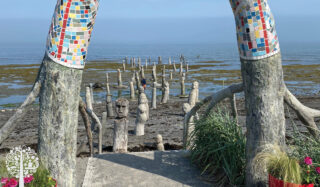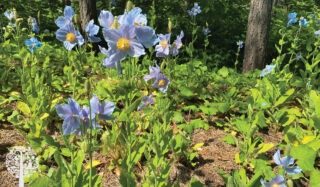Quebec’s Gaspesie region is renowned worldwide for its dramatic coastal landscapes, stunning national parks, and salty seaside air. It’s a place rich in history, beginning with the First Nations people who witnessed the arrival of the Vikings, Italian explorers, and the Basque and Breton fishermen crossing the St-Lawrence (1). You don’t have to book an expensive cruise to see whales or seals in the Gaspé; they’re as much a part of the landscape as the cliffs. With breathtaking hiking trails for all fitness levels and natural wonders like the Percé Rock, it’s the perfect destination for nature lovers looking for peace, quiet, and outdoor therapy.
Road Trip!
With that in mind and a desire to explore our province, my family and I headed to the Gaspesie in early July. Nearly an 11-hour drive from our home in the Laurentians, we broke the journey in half to keep our three kids from going stir-crazy in the back seat. Sleeping under the stars seemed natural for the first night of our eco-tour, so we booked a bubble tent with a transparent roof (that’s right, parents, your dreams of putting your accident-prone middle child in a bubble can come true in Sainte-Flavie, QC!). The next day, we stopped at the Centre d’Art Marcel Gagnon, a unique seaside art gallery featuring wooden sculptures you can only see at low tide, before heading to the Reford Gardens, a place I didn’t know was on my bucket list until I saw it.


Elsie Reford and Les Jardins de Métis
Also known as Les Jardins de Métis, the Reford Gardens are located in the northern part of the Gaspé Peninsula, about 300 kilometers northeast of Quebec City. They are the northernmost gardens in eastern North America (2), making the abundance of plant life growing there all the more impressive.
Elsie Reford (1872-1967) was the mastermind behind this gorgeous space, although she never set out to be a horticulturist. Instead, she was an outdoor enthusiast and used her camp in Grand-Métis for hunting, fishing, canoeing, and horseback riding. But in 1926, at 54, she was sidelined by appendicitis and needed surgery. Afterward, her doctor recommended she find less physically demanding activities to occupy her time, so she decided to convert her 20-acre property into gardens.
Work In Progress
When she first developed the concept, Reford’s camp was barren except for a spruce-lined entrance and a simple cedar hedge. She dug, built stone walls, and moved trees to create a beautiful forested oasis. Despite the challenging weather conditions, Reford selected rare plant varieties for her gardens, including azaleas and blue poppies from Tibet. She created and fostered relationships with local farmers and fishing guides, trading leaves with the farmers in exchange for refined compost to help her exotic and native plant collection grow. Even with the community’s help, transforming the property took three decades of hard work. I’m unsure how this venture complied with the doctor’s orders for less strenuous activity, but the results were well worth the effort.
Good for the Soul
The word magnificent doesn’t do the Reford Gardens justice, and it’s no wonder they’ve been declared a National Historic Site of Canada. The property features 15 garden spaces and 3,000 plant species and varieties. The Entrance Garden welcomes visitors with winding pathways shaded by mature white spruce trees. Groundcovers and plants of various heights and sizes intermingle along the trail, including Lady’s mantle, sedum, lilies, and cicerbeta. The Entrance Garden also features wooden bridges that cross the rushing stream that meanders throughout the property. You can’t help but instantly feel at peace, the gardens doing exactly what they’re meant to do for the soul.
Eventually, the gravel paths giveaway to the spectacular Stream Garden, which looks like a well-kept secret nobody else knows about. The hills on either side of the stream are a wild and lush paradise featuring rock gardens, trees and shrubs, stone pathways, and benches for sitting and taking it all in. Irises, mosses, lichens, and unique bonsai shrubs grow in this space, creating a visually exciting and complex ecosystem.
Exotic Blue Poppies
The Reford Gardens are most famous for the blue poppies, which bloom from the end of June through July and are featured in abundance in the Blue Poppy Glade. The blue flowers with delicate petals are tough to grow, yet Elsie Reford succeeded. Native to the alpine valleys of the Himalayas, Reford got the seeds from the Royal Botanic Garden in Edinburgh and brought them back to Grand-Métis around 1935 (3). She found the blue poppies loved the moist and mild climate in the region and were protected by the early and heavy snow cover. She shaded them from the harsh sun by growing them under a crab apple and birch tree canopy. The periwinkle blue flowers pop against a backdrop of ostrich ferns, white martagon, and Turk’s Cap lilies that round out the space. Anyone open to the horticultural challenge of growing blue poppies in their home gardens can purchase seeds at the gift shop (among many other seed varieties).


Endless Beauty and Inspiration
The Vegetable Garden is what dreams are made of and features crops like Egyptian garlic, kale and cabbages, lettuce greens, and so much more. Surrounded by a white picket fence and pollinator-friendly flowers, it leaves you feeling inspired and hungry for more. The Long Walk is a breathtaking stroll through an English cottage-style garden featuring trees, shrubs, and blooms of all colors. There’s a serene meadow with lupins galore, and the House Gardens make you want to pack your bags and move in for good, if not for the plants, then the gorgeous wrap-around porch overlooking them. The Primula Glade and Alpin Garden are must-sees on your way to the Bird Garden, a paradise for bird watchers and gardeners who appreciate everything this species offers. Gorgeous arbors and gazebos covered with honeysuckle are natural nesting spots, as are the many birdhouses scattered throughout the walkways and meadows. The pond in this part of the garden includes a migration ramp for the American eel, which helps the at-risk species access its natural habitat.


La La Land
Our two-year-old fell asleep in his stroller mid-way through our tour, a small miracle if you understand how much energy this kid has. But my entire family could have drifted off after our visit; we felt calm, relaxed, and uplifted. As we headed to the car for the final leg of our journey to Forillion National Park in the Gaspé, I felt justified in some of the plant choices I have made in my garden. If Elsie Reford liked them, they must be wonderful. I also felt inspired to do more and do better. While my garden will never span 20 acres, I can create a space on a much smaller scale that attracts wildlife, improves the soil, and feeds us and our pollinator friends while offering some much-needed garden therapy. I took notes of various plant species I haven’t tried growing and want to incorporate into my property; it’s all part of my 30-year plan.
Sources:
- Tourisme Gaspesie (tourisme-gaspesie.com)
- Reford Gardens (jardinsdemetis.com)
- Must-See Attractions Gaspesie (attraitsgaspesie.com/en/blog/growing-blue-poppies/18)
